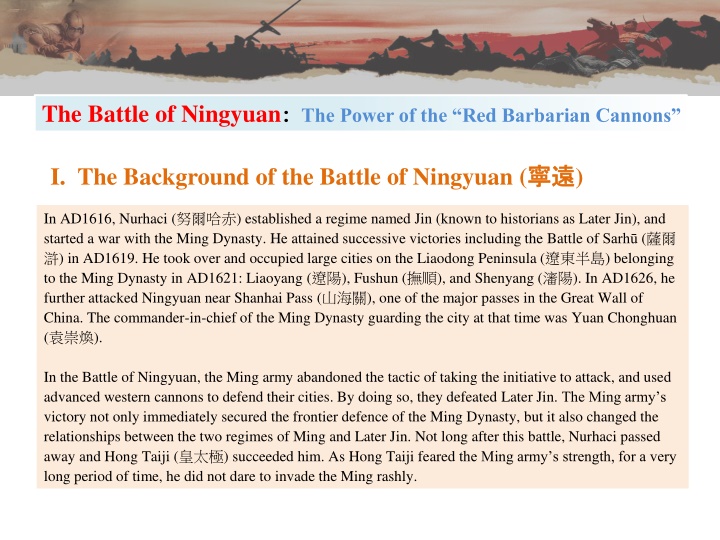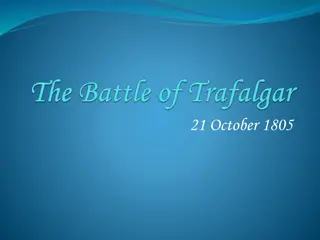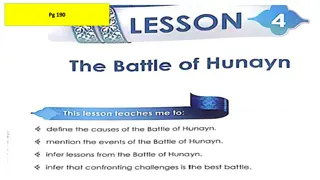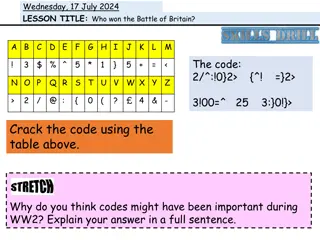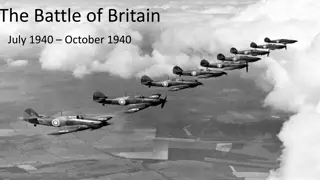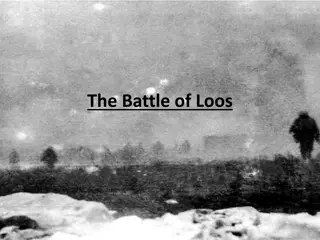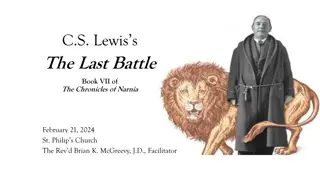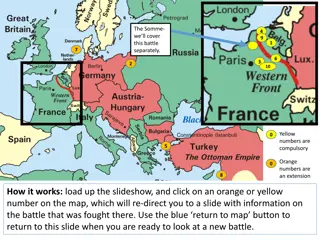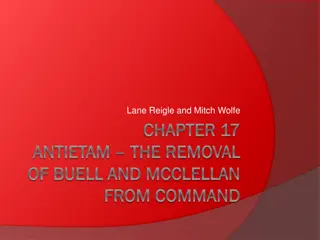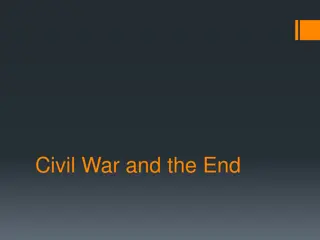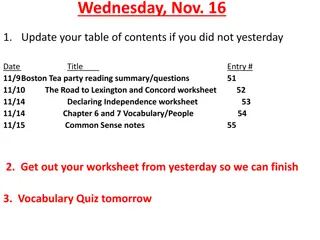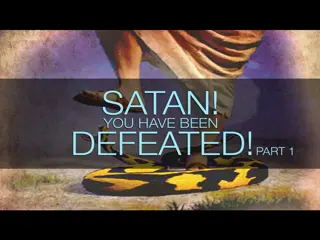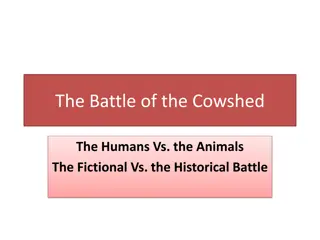The Battle of Ningyuan: Victory and Strategic Impact in AD 1626
Nurhaci's Later Jin regime clashed with the Ming Dynasty in the Battle of Ningyuan in AD 1626, resulting in a Ming victory due to innovative use of western cannons. This crucial battle secured the Ming frontier defense and altered the power dynamics between the two regimes significantly. Nurhaci's subsequent reluctance to invade the Ming was a direct result of this defeat. The battle tactics, weapons, and historical context of this conflict are explored in detail.
Download Presentation

Please find below an Image/Link to download the presentation.
The content on the website is provided AS IS for your information and personal use only. It may not be sold, licensed, or shared on other websites without obtaining consent from the author.If you encounter any issues during the download, it is possible that the publisher has removed the file from their server.
You are allowed to download the files provided on this website for personal or commercial use, subject to the condition that they are used lawfully. All files are the property of their respective owners.
The content on the website is provided AS IS for your information and personal use only. It may not be sold, licensed, or shared on other websites without obtaining consent from the author.
E N D
Presentation Transcript
The Battle of NingyuanThe Power of the Red Barbarian Cannons I. The Background of the Battle of Ningyuan ( ) In AD1616, Nurhaci ( ) established a regime named Jin (known to historians as Later Jin), and started a war with the Ming Dynasty. He attained successive victories including the Battle of Sarh ( ) in AD1619. He took over and occupied large cities on the Liaodong Peninsula ( ) belonging to the Ming Dynasty in AD1621: Liaoyang ( ), Fushun ( ), and Shenyang ( ). In AD1626, he further attacked Ningyuan near Shanhai Pass ( ), one of the major passes in the Great Wall of China. The commander-in-chief of the Ming Dynasty guarding the city at that time was Yuan Chonghuan ( ). In the Battle of Ningyuan, the Ming army abandoned the tactic of taking the initiative to attack, and used advanced western cannons to defend their cities. By doing so, they defeated Later Jin. The Ming army s victory not only immediately secured the frontier defence of the Ming Dynasty, but it also changed the relationships between the two regimes of Ming and Later Jin. Not long after this battle, Nurhaci passed away and Hong Taiji ( ) succeeded him. As Hong Taiji feared the Ming army s strength, for a very long period of time, he did not dare to invade the Ming rashly.
II. The Prelude to the Battle of Ningyuan and the Battle Tactics of the Two Sides A. The Route of Nurhaci s Advancing Soldiers 1621 1621 1619 1621 Quiz: Please fill in the blanks on the right map with the below place names: Liaoyang Hetu Ala Shanhai Pass Sarh Fushun Ningyuan Shenyang
Fushun 1621 1621 Sarh Shenyang 1619 1621 Hetu Ala Liaoyang Ningyuan Shanhai Pass
B. The Battle Tactics and the Weapons of Both Sides First, examine Later Jin s battle tactics Nurhaci Nurhaci AD1559 Nurhaci was born AD1583 He became the leader of the Left Guard of the Jianzhou Jurchens AD1591 He unified all tribes of Jurchens in Manchuria AD1616 He established a regime named Jin, announced his Seven Grievances against the Ming (including the murder of his father and grandfather, disrespect shown to his envoys and various border violations), and started a war with the Ming Dynasty. During the rule of Later Jin s Supreme Khan Nurhaci, he did not leave behind any portraits. The image we see now is an illustration from Manzhou Shilu (Manchu Veritable Records ). It was originally from Qing Taizu Shilu Zhan Ji Tu (Veritable Record of Qing Taizu s Battles Images ) which was compiled by Hong Taiji when he became the emperor in AD1635. Since the date of production was close to the time period of Nurhaci s rule, we can trust that these images are the most capable of showing Nurhaci s circumstances in the war at that time.
The Battle Tactics of Later Jin Soldiers: Mounted Archery This was Nurhaci s first battle after he began to command the Left Guard of Jianzhou Jurchens. He attacked Tulun city ( ). Previously in AD1582, the leader of Tulun city, Nikan Wailan ( ), had persuaded the Ming commanders to join him in an attack of Fort Gure ( ) which was the city of another tribe leader, Atai. In the battle, Nurhaci s paternal grandfather, Giocangga ( ), and father, Taksi ( ), were killed. Once Nurhaci had become the tribe leader, he planned the revenge. In this battle (see the image on the left), you can see Nurhaci wearing an armour, riding a horse, wielding a knife, and carrying a bow and arrows. All other soldiers, regardless of offensive or defensive use traditional weapons.
The archery techniques of the Jurchens were different from those of the Europeans. The Europeans were accustomed to using their middle three fingers to nock an arrow to their bow. However, the Jurchens used their thumbs to nock the arrow to their bow (only using their index fingers to assist a bit). To protect their thumbs on their bowstring hands, archers could wear a jade ring.
The Weapons of the Ming Army: Guns In AD1619, Ming Dynasty tried to send soldiers to the Battle of Sarh to eliminate Nurhaci. In this battle, Jin soldiers (left side of picture) were still riding horses and shooting bows and arrows. However, Ming soldiers (right side of picture) were already using large quantities of firearms. The infantry of the Ming Dynasty divided themselves into two rows, and took turns to fire their guns. This became known as repeated fire .
Windchasing Gun Ming guns known as chong or zhuifeng qiang (windchasing gun) were illustrated in the AD1636 s military book, Junqi tushuo (Illustrated Army Weapons ), which was written by Bi Maokang ( ). According to the book, the windchasing gun was 5 Chinese feet and 2 Chinese inches long. It weighed 16 catties. Its lead bullets weighed 1.5 qian (or 0.15 tael) and every shot of gunpowder weighed 3 qian. It could shoot through iron plates within 40 steps away. In the battles, soldiers could be divided into three rows and used the repeated fire tactic. Shooting Ready (to shoot) Reloading
Quiz What we call the windchasing gun was actually a foreign-introduced matchlock gun. How it worked can be divided roughly into four parts. Please fill in the numbers for each stage. 4 1 2 3
Operation Number Putting gunpowder in the gun barrel Aiming at the target Putting gunpowder into small containers Using rod to push gunpowder and lead inside the gun barrel interior 4 3 1 2
Operation Number Putting gunpowder in the gun barrel 2 Aiming at the target 4 Putting gunpowder into small containers 1 Using rod to push gunpowder and lead inside the gun barrel interior 3 4 3 1 2
Think: Reflect on the above images and activities, and then answer the questions below: 1. Why did the Ming army need to use the tactic of repeated fire to fire guns? 2. Do you think the Ming or Later Jin owned more advanced weapons? Try to explain why the Ming army lost this battle through the perspective of weapon operations. (see the following images)
Ming Army Artillery: Breech- Loading Swivel Cannon In AD1621, Nurhaci led Later Jin soldiers to invade Liaoyang city. Ming defenders equipped their guns and cannons and then exited the city. Separated by a moat, they fired on the enemy. Cannon soldier Cannon soldier Gun soldier The breech-loading swivel cannon was introduced by the Portuguese in final years of Emperor Zhengde ( ) of the Ming Dynasty (early 16th century). It quickly became the Ming army s main type of cannon. Gun soldier Cannon soldier Quiz: Why did the Ming army need to move the cannons outside the city to fire them?
Breech-Loading Swivel Cannon Illustration A big stone cannonball was used for destroying castle walls. When attacking soldiers, it would be a number of small shots. Chamber Each swivel cannon barrel was fitted with 5-9 chambers for rotation. By loading cannonballs and gunpowder into the chambers beforehand, the time between firing could be cut shorter. Gunpowder Fuse The breech-loading swivel cannon was installed on an artillery cart. It needed at least three soldiers to operate it. The breech-loading swivel cannon was composed of two parts, the swivel gun barrel and the mug- shaped chamber containing gunpowder and projectile. Cannon barrel Chamber Source: Tujie Zhongguo Wuqi Jicheng (Illustrated Chinese Weapons), p.45
In the sixteenth century, every country s navy vessels had breech- loading swivel cannons on the sides of their decks. (Photographed in the Macau Maritime Museum)
English swivel cannon. This eras swivel cannons were made out of pig iron. (Photographed in Newcastle s The Old Castle )
Think: Having seen the above explanations, what weak points have you discovered in the breech-loading swivel cannon? The weak points of the breech-loading swivel cannons During the Jiajing ( ) period (AD1521-1567), the Ming Dynasty copied the breech-loading swivel cannons and called them the Wudi Dajiangjun Pao (Unrivalled and the Great General Cannon). They installed them on the city walls or on the artillery carts for land-based use. In AD1537, 3,900 different types of breech-loading swivel cannons were made with varying calibers. Breech-loading swivel cannons shot stone cannonballs, but a number of spherical pellets could also be used. They caused great casualties among enemies within their firing range. Source: Yihai zhuchen ( ), Wu Shenglan ed., Jiaqing period (AD1760-1820) However, the breech-loading swivel cannon had some weaknesses in its design, namely weak firing power and short range. Firing the cannon relied on gunpowder combustion to create gas and push out the cannonball. The breech loading swivel cannon was actually composed of two parts, the swivel cannon barrel and the chamber. Therefore, when the cannonball was being fired and entered the swivel cannon barrel, gas would leak where the breech and swivel cannon barrel joined. This consequently lowered its firing power. This was the main reason why the Ming army needed to move the breech-loading swivel cannon outside the city to target at Later Jin soldiers more closely in the Battle of Liaoyang. However, this meant that the artillery soldiers were not shielded behind the city walls and were easily injured by enemy soldiers. In 1621, Nurhaci, armed with traditional weapons, stormed Liaoyang. His next objective became Ningyuan.
Photographed in Dongguan Yuan Chonghuan Commemoration Garden. On the 14thof the first lunar month of AD1626, Nurhaci and his army had conquered several cities on the Liaodong Peninsula including Jinzhou ( ), and around Linghe ( ), Songshan ( ), and Xingshan ( ). On the 23rd of the month, Ningyuan was surrounded by Nurhaci. The city commander, Yuang Chonghuan, encouraged officers and soldiers to swear an oath to live or die with the city. At last, Yuan defeated the invaders using his newly introduced large western cannons (xiyang dapao). The large western cannons mentioned above were muzzle- loading culverins, a new weapon imported by the Ming government from foreign countries.
Muzzle-loading culverins, also known as red barbarian cannons in the Ming ( red barbarian probably referred to the Portuguese and Spanish who introduced the new cannons to China at that time) The biggest technological improvement shown in the muzzle-loading culverins was the use of one long cannon barrel. This replaced the breech-loading swivel cannon. When the gunpowder was ignited, the gases would not leak and this increased the firing range and power of the cannon. This is the part where gunpowder was ignited. To prevent the cannon barrel from exploding, metal rings were used to reinforce the barrel. Cannon opening
Muzzle-loading culverins used in the Battle of Ningyuan have not survived to this day. The image on the left comes from the early cannons of Rome s Castel Sant Angelo. Perhaps this was how early muzzle-loading culverins looked. This artillery cart was made of wood, with a back that was peeled flat to place cannonballs in preparation to fire. Muzzle-loading culverins used iron cannonballs. This stone cannonball probably does not belong to this cannon. The museum places it here only to keep the artillery cart balanced. Photographed in Rome s Castel Sant Angelo
The history of Mings purchase of muzzle-loading culverins Year Event The Battle of Sarh was lost. Xu Guangqi ( ), a Ming court official, sent someone to visit Macau and negotiated with the Portuguese on the purchase of the advanced western cannons. The Ming consequently acquired muzzle-loading culverins, which replaced the breech-loading swivel cannons. AD1619 AD1621 In the twelfth month, Liaoyang was lost. Four of the newest style western cannons bought in Macau were being shipped to Beijing. AD1623 In the fourth month, 24 Portuguese cannon experts arrived at Beijing to test the cannons in front of the Ming emperor. One cannon exploded and one gunner consequently died. However, the entire imperial court still saw the power of these cannons and therefore started to make purchasing orders. They then transported them to Liaodong cities including Ningyuan. AD1626 When Nurhaci invaded Ningyuan, the city walls above him were already equipped with 16 muzzle-loading culverins.
Ningyuan The city wall, first built in AD1430, was made of bricks. It was about 10 metres high and 800 metres wide. The city s design was that of a traditional Chinese design (four-sided city). It had four gates and each with a barbican city gate to defend it. In the Battle of Ningyuan in AD1626, Yuan Chonghuan was the commander-in-chief and he sent Zhu Mei ( ), Man Gui ( ), Zu Dashou ( ) and Zuo Fu ( ) to defend the city gates. Zhu Mei Yuan Zuo Fu Man Gui Chonghuan Quiz: Where was the four-sided city s defensive blind spot? (1) Barbican city gate, or (2) City corner? (see behind for answers) Zu Dashou
III. The Battle of Ningyuan (AD1626): Process and Results Commander-in-Chief Ming: Yuan Chonghuan; 20,000 soldiers Later Jin: Nurhaci; 60,000 soldiers On the 18thof the first lunar month, Yuan Chonghuan obtained information that Later Jin soldiers had invaded. He then began to prepare for the battle. Equipped with muzzle-loading culverins, Yuan changed the practice of Ming army custom of using cannons outside the city and instead concentrated all his armed forces with those modern culverins inside the city for a tight defense. He took steps including (1) to completely burn all houses and granaries outside the city, and (2) to move all nearby soldiers inside the city. On the 23rd, Later Jin soldiers approached Ningyuan. They did not expect that Ming soldiers would have new weapons. When Later Jin soldiers were 5 li north of the city, Ming army suddenly fired their cannons and killed scores of enemies. Later Jin soldiers hurriedly moved their tents so as to leave the fire zone. On the 24th, Nurhaci began his siege and focused his attack on the city corner s blind spots.
The Siege Weapons of Later JinArmy Shield: This protected soldiers from arrows shot from the top of the city wall Later Jin soldiers built up a mound under the shield and attempted to follow the mound to climb on the top of the city wall. Mobile shield: To shield the advancing soldiers Archers Think: Do you think that the above siege weapons could resist against the modern red barbarian cannons ?
This siege battle happened on the 24thand 25thday in the first lunar month. The Ming army hid constantly inside the city firing cannons. According to the historical records, every time the western cannons were used, Later Jin siege equipment would be shattered by the bombardment and there would be countless Later Jin casualties. Cannon on the city wall
On the evening of the 25thday, the battle concluded. The corpses of invaders were piled up at the city walls and Later Jin soldiers quickly moved the casualties away. Corpses were taken to the nearby villages to burn and yellow smoke covered the sky. On the 26thday, Later Jin retreated. In the same year, Nurhaci (aged 67) also died of unknown causes. The Ming Dynasty announced that he died from having sustained too many cannon injuries in this battle. Later Jin soldiers carried and supported each other. They helped wounded fellow soldiers to leave the battlefield full of cannon fire.
Image from the Shanhaiguan Great Wall Museum website. Material: copper Length 49.5cm Outer diameter: 12.2cm Inner diameter: 4.3cm Weight: 38.75kg Quiz: The Shanhaiguan Great Wall Museum has a Ming Dynasty s cannon. Can you, according to the prompts below, introduce this cannon? Long cannon or short cannon? Which of the two can you put completely on your school desk? Short cannon Carved on it is (Lit., Magical cannon made in the 3rdyear of the Tianqi reign for pacifying frontier regions). Is it foreign imported or locally made in China? Which year (western calendar) was it made? This small hole has a diameter of 1.6cm. What is the use of it? This part of copper is especially thick. Why? Gunpowder chamber Detonator hole Locally made inAD1623
